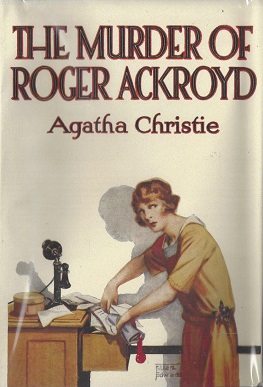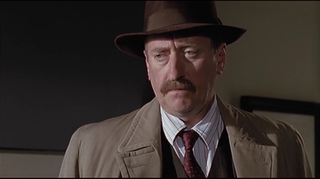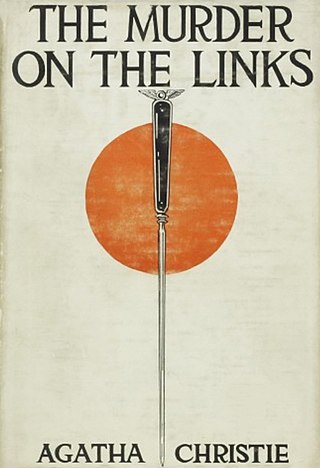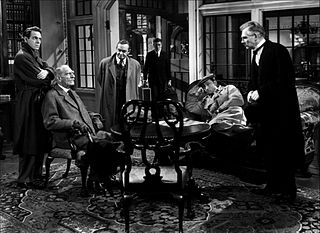Plot summary
Set in post-war [1] London and at Elstree Studios, Hertfordshire, the "mysterious affair" of the title is the murder of ageing actress Cora Rutherford on the set of the film which she hopes will mark her comeback to the silver screen. As it happens, mystery writer Evadne Mount, an old friend of Cora's, and Chief-Inspector Trubshawe, retired, formerly of Scotland Yard, are watching the shooting of the scene in which the actress drinks from a champagne glass whose content, unbeknownst to everyone except the murderer, has been laced with a strong poison. Right from the start of the investigation, a neat group of suspects presents itself to the police. However, although each of them would have had means and opportunity to kill Cora Rutherford, none of them has the slightest motive to have done so. It takes amateur sleuth Evadne Mount several days to figure out the solution to the crime, and only by linking up the murder with an accident which happened some time previously, and eventually by using a decoy, is she able to solve the case.
Cultural references
In a postmodernist fashion, Adair not only has his characters, especially Evadne Mount, discuss red herrings, twist endings, spoilers, and reader response in general, [2] he also tells a story in which he both obeys and transgresses the boundaries and conventions of the Golden Age whodunit. On the one hand, there is no violence, let alone police brutality, anywhere in the novel; the suspects are interrogated one after another in an orderly manner; during her investigation into the crime Evadne Mount accidentally finds a piece of paper with a cryptic message written on it; and in the end, when all suspects have been assembled at the scene of the crime to be told which of them has done it, it is indeed the least likely person who turns out to be the killer.
On the other hand, Adair toys with, and transcends, some of the conventions of the genre. For example, Cora Rutherford is murdered rather late in the novel, which is clearly against the rules. In a paraphrase of Ronald Knox, who claimed in 1929 that the elements of the mystery have to be "clearly presented to the reader at an early stage in the proceedings", Evadne Mount says so herself :
In real life, the seed of virtually every serious crime, not only murder, is sown long before the performance of the act itself. Yet it's one of the cast-iron rules of the whodunit, a crucial clause in the contract between writer and reader, that a murder be perpetrated, or at the least attempted, within the first twenty or thirty pages of the book. To leave it to the halfway mark would be a serious test of the reader's patience. [3]
Yet in A Mysterious Affair of Style the murder of Cora Rutherford occurs on page 123, almost halfway through the book. Also, neither of the three people investigating the murder is attributed the role of the Watson. Rather, Evadne Mount, Trubshawe and Calvert, a young Scotland Yard detective and former protégé of Trubshawe, form a perfect team and are at one point referred to as "the three friends". [4]
Clearly Adair is taking liberties when he makes Evadne Mount president of the Detection Club (which at the time was headed by E. C. Bentley). While there are references to British followers of the "thick-ear school"—the hardboiled style of crime writing— such as Peter Cheyney and James Hadley Chase, Evadne Mount's major worry is Agatha Christie herself, "the rival in whose shadow it would seem she was eternally condemned to languish" [5] despite the more than twenty successful whodunits she has published herself. Mount's long-running stage play, The Tourist Trap, anachronistically echoes Christie's The Mousetrap , which has been running in the West End since 1952.
Alastair Farjeon, the film director in the novel, appears to be a thinly disguised Alfred Hitchcock. Farjeon specializes in thrillers but, contrary to Hitchcock's practice, always writes his own stories and screenplays, which he then turns into successful films such as Remains to be Seen (about a photographer being stabbed while he is taking a picture of a group of archaeologists at an excavation site in Egypt) or An American in Plaster-of-Paris (alluding, again anachronistically, to both the 1951 movie, An American in Paris and the plot of Hitchcock's 1954 thriller, Rear Window ). His surname is a reference to Joseph Jefferson Farjeon, another prolific golden age British mystery writer, some of whose stories were adapted for the cinema.
However, it turns out that Farjeon has stolen the script of If Ever They Find Me Dead—the film during whose shooting Cora Rutherford is murdered—from Philippe Françaix, one of his most ardent admirers and a fledgling film theorist in his own right who has copied his master's style and written an original screenplay in honour of his idol. The character of Philippe Françaix seems to be modelled on film critic and film theorist André Bazin or maybe François Truffaut who, in 1954, advocated auteur theory, claiming that a director's films reflect that director's personal creative vision, as if he or she were the primary "auteur," and that a film critic can only write a review of a film if they like it.
References are also made to Julien Duvivier, René Clair, Ernst Lubitsch, William Wyler, and Orson Welles.
Cora Rutherford's surname is probably derived from the actress Margaret Rutherford who played Agatha Christie's Miss Marple in a series of MGM films in the early 1960s.
Finally, Adair creates a 1940s milieu by making (occasionally politically incorrect) references to, among many other things, dirty weekends, street urchins, spivs, "syncopated Negro music", "frogs" (such as Philippe Françaix), Woodbines, and the 'phone.

Dame Agatha Mary Clarissa Christie, Lady Mallowan, was an English writer known for her 66 detective novels and 14 short story collections, particularly those revolving around fictional detectives Hercule Poirot and Miss Marple. She also wrote the world's longest-running play, the murder mystery The Mousetrap, which has been performed in the West End since 1952. A writer during the "Golden Age of Detective Fiction", Christie has been called the "Queen of Crime". She also wrote six novels under the pseudonym Mary Westmacott. In 1971, she was made a Dame (DBE) by Queen Elizabeth II for her contributions to literature. Guinness World Records lists Christie as the best-selling fiction writer of all time, her novels having sold more than two billion copies.
Miss Jane Marple is a fictional character in Agatha Christie's crime novels and short stories. Miss Marple lives in the village of St. Mary Mead and acts as an amateur consulting detective. Often characterized as an elderly spinster, she is one of Christie's best-known characters and has been portrayed numerous times on screen. Her first appearance was in a short story published in The Royal Magazine in December 1927, "The Tuesday Night Club", which later became the first chapter of The Thirteen Problems (1932). Her first appearance in a full-length novel was in The Murder at the Vicarage in 1930, and her last appearance was in Sleeping Murder in 1976.

Detective fiction is a subgenre of crime fiction and mystery fiction in which an investigator or a detective—whether professional, amateur or retired—investigates a crime, often murder. The detective genre began around the same time as speculative fiction and other genre fiction in the mid-nineteenth century and has remained extremely popular, particularly in novels. Some of the most famous heroes of detective fiction include C. Auguste Dupin, Sherlock Holmes, and Hercule Poirot. Juvenile stories featuring The Hardy Boys, Nancy Drew, and The Boxcar Children have also remained in print for several decades.

A whodunit or whodunnit is a complex plot-driven variety of detective fiction in which the puzzle regarding who committed the crime is the main focus. The reader or viewer is provided with the clues to the case, from which the identity of the perpetrator may be deduced before the story provides the revelation itself at its climax. The investigation is usually conducted by an eccentric, amateur, or semi-professional detective.

Crime fiction, detective story, murder mystery, mystery novel, and police novel are terms used to describe narratives that centre on criminal acts and especially on the investigation, either by an amateur or a professional detective, of a crime, often a murder. It is usually distinguished from mainstream fiction and other genres such as historical fiction or science fiction, but the boundaries are indistinct. Crime fiction has multiple subgenres, including detective fiction, courtroom drama, hard-boiled fiction, and legal thrillers. Most crime drama focuses on crime investigation and does not feature the courtroom. Suspense and mystery are key elements that are nearly ubiquitous to the genre.

Mystery is a fiction genre where the nature of an event, usually a murder or other crime, remains mysterious until the end of the story. Often within a closed circle of suspects, each suspect is usually provided with a credible motive and a reasonable opportunity for committing the crime. The central character is often a detective, who eventually solves the mystery by logical deduction from facts presented to the reader. Some mystery books are non-fiction. Mystery fiction can be detective stories in which the emphasis is on the puzzle or suspense element and its logical solution such as a whodunit. Mystery fiction can be contrasted with hardboiled detective stories, which focus on action and gritty realism.

The Mysterious Affair at Styles is the first detective novel by British writer Agatha Christie, introducing her fictional detective Hercule Poirot. It was written in the middle of the First World War, in 1916, and first published by John Lane in the United States in October 1920 and in the United Kingdom by The Bodley Head on 21 January 1921.

The Murder of Roger Ackroyd is a detective novel by the British writer Agatha Christie, her third to feature Hercule Poirot as the lead detective. The novel was published in the UK in June 1926 by William Collins, Sons, having previously been serialised as Who Killed Ackroyd? between July and September 1925 in the London Evening News. An American edition by Dodd, Mead and Company followed in 1926.

Captain Arthur J. M. Hastings, OBE, is a fictional character created by Agatha Christie as the companion-chronicler and best friend of the Belgian detective, Hercule Poirot. He is first introduced in Christie's 1920 novel The Mysterious Affair at Styles and appears as a character in seven other Poirot novels, including the final one Curtain: Poirot's Last Case (1975), along with a play and many short stories. He is also the narrator of several of them.

Inspector James Japp is a fictional character who appears in several of Agatha Christie's novels featuring Hercule Poirot.

The Murder on the Links is a work of detective fiction by Agatha Christie, first published in the US by Dodd, Mead & Co in March 1923, and in the UK by The Bodley Head in May of the same year. It is the second novel featuring Hercule Poirot and Arthur Hastings. The UK edition retailed at seven shillings and sixpence (7/6), and the US edition at $1.75.

After the Funeral is a work of detective fiction by Agatha Christie and first published in the US by Dodd, Mead and Company in March 1953 under the title of Funerals are Fatal and in UK by the Collins Crime Club on 18 May of the same year under Christie's original title. The US edition retailed at $2.50 and the UK edition at ten shillings and sixpence (10/6).

Peril at End House is a work of detective fiction by British writer Agatha Christie, first published in the US by the Dodd, Mead and Company in February 1932 and in the UK by the Collins Crime Club in March of the same year. The US edition retailed at $2.00 and the UK edition at seven shillings and sixpence (7/6).

A Murder Is Announced is a work of detective fiction by Agatha Christie, first published in the UK by the Collins Crime Club in June 1950 and in the US by Dodd, Mead and Company in the same month. The UK edition sold for eight shillings and sixpence (8/6) and the US edition at $2.50.

The Golden Age of Detective Fiction was an era of classic murder mystery novels of similar patterns and styles, predominantly in the 1920s and 1930s.

The Act of Roger Murgatroyd: An Entertainment is a whodunit mystery novel by Scottish novelist Gilbert Adair first published in 2006. Set in the 1930s and written in the vein of an Agatha Christie novel, it has all the classic ingredients of a 1930s mystery and is, according to the author, "at one and the same time, a celebration, a parody and a critique not only of Agatha Christie but of the whole Golden Age of English whodunits", but also "a whodunit in its own right, so that those readers who were completely uninterested in literary games of the so-called postmodern type could nevertheless settle down comfortably with a good, gripping and intentionally old-fashioned thriller." The Act of Roger Murgatroyd is also a "locked room mystery" and is also a part of Adair's Evadne Mount trilogy.
Trubshaw or Trubshawe is a family name, and may refer to:
The Evadne Mount trilogy is a series of books written by Gilbert Adair featuring mystery-writer-cum-sleuth Evadne Mount.

And Then There Was No One is a novel by Gilbert Adair first published in 2009. After The Act of Roger Murgatroyd and A Mysterious Affair of Style, it is the third book in the Evadne Mount trilogy. However, rather than being yet another more or less straightforward whodunit, albeit with postmodern overtones, And Then There Was No One thoroughly blurs the boundaries between reality and fiction; or rather, reality, fiction, and metafiction.

The closed circle of suspects is a common element of detective fiction, and the subgenre that employs it can be referred to as the closed circle mystery. Less precisely, this subgenre – works with the closed circle literary device – is simply known as the "classic", "traditional" or "cozy" detective fiction.
















